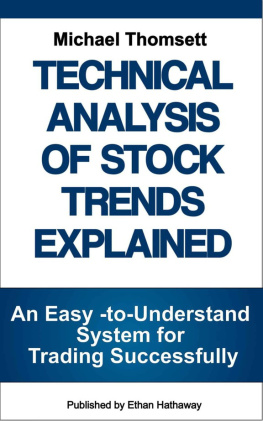Technical Analysis of Stock Trends Explained: An Easy-to-Understand System for Successful Trading
by Michael Thomsett.
Published by Ethan Hathaway Co Ltd
Copyright 2012. Michael Thomsett.
All Rights Reserved.
Be sure to check out the companion course to this book at:
http://www.ethanhathawayonline.com/technicalanalysisonlinetrainingcourse/
Purchasers of this book are entitled to a special offer on the companion online course. Special offer may be found at the end of this book.
Legal Disclaimer
Thes information contained in this book are not a recommendation to buy or sell, but rather a guideline to interpreting the specified analysis methods. Investors who are aware of the risks inherent in securities trading should only use this information. Ethan Hathaway Co Ltd and Michael Thomsett accept no liability whatsoever for any loss arising from any use of this information and these products or their contents.
Every effort has been made to accurately represent this product and its potential. There is no guarantee that you will earn any money using the techniques and ideas in these materials. Examples in these materials are not to be interpreted as a promise or guarantee of earnings. Earning potential is entirely dependent on the person using our product, ideas and techniques. We do not purport this as a get rich scheme.
Any claims made of actual earnings or examples of actual results can be verified upon request. Your level of success in attaining the results claimed in our materials depends on the time you devote to the program, ideas and techniques mentioned, your finances, knowledge and various skills. Since these factors differ according to individuals, we cannot guarantee your success or income level. Nor are we responsible for any of your actions.
Materials in our product and our website may contain information that includes or is based upon forward-looking statements within the meaning of the securities litigation reform act of 1995. Forward-looking statements give our expectations or forecasts of future events. You can identify these statements by the fact that they do not relate strictly to historical or current facts. They use words such as anticipate, estimate, expect, project, intend, plan,
believe, and other words and terms of similar meaning in connection with a description of potential earnings or financial performance.
Any and all forward looking statements here or on any of our sales material are intended to express our opinion of earnings potential. Many factors will be important in determining your actual results and no guarantees are made that you will achieve results similar to ours or anybody elses, in fact no guarantees are made that you will achieve any results from our ideas and techniques in our material.
PART I: INTRODUCTION
Traders have heard about fundamental analysis and technical analysis and often decide to become adherents to one or the other. However, you can use both of these to:
a. complement one another and improve skills in timing of trades.
b. confirm and cross-confirm reversal indicators.
c. create a wide view that brings in elements of price as well as financial trends.
Segment 1. Fundamental vs. technical analysis. (Differences and similarities; using both together in a coordinated program.)
The differences between these two approaches to analysis are significant. Fundamental analysis is defined as the study of financial trends (profitability and cash flow), expressed in ratios, and involving several years worth of status and results. It includes many components, all based on the historical financial record. Among these, the most significant results are:
a. revenues and earnings over several years, aimed at spotting trends that may be either positive or negative. For example, if revenues are erratic or flat, it is difficult to estimate future direction. If revenues are rising but net profit (or net return) is declining, it is a sign of poor controls by management; if net earnings rise and net return is steady or improving, that is a signal of positive growth.
b. debt ratio measures the organizations reliance on borrowings, versus the use of equity to fund growth. This is derived by dividing long-term debt by total capitalization. (Total cap is the sum of long-term debt plus shareholders equity). If the debt ratio is high or increasing, it means future net earnings will have to be devoted increasingly to debt service and interest expense, and less for funding expansion or paying dividends.
c. dividend yield is a key fundamental, and investors seek companies whose dividend is steady or growing. Those whose dividends have increased every year for 10 years or more (called dividend achievers) have tended over time to out-perform the market in general, and have also been able to minimize the year-to-year volatility in financial results more successfully than companies whose dividend has fallen or been missed.
d. price/earnings ratio is an oddity because it compares a technical indicator (price) to a fundamental (earnings). A potential problem is that price is current and earnings are historical. For this reason, a study of PE should involve several years of the range of PE. Investors seek consistency and a relatively modest range. When the multiple of PE is too high, the stock is probably overpriced; when too low, it indicates a lack of interest in the company.
e. fundamental volatility goes beyond the study of a multi-year trend, such as that for revenues and earnings. It is a study of the reliability in year-to-year changes. Investors like predictability, such as steady revenue and earnings growth and a reliable and consistent net return. Some results, however, tend to be highly volatile, with results ranging from high revenues and earnings one year, to reduced revenues and a net loss the next. This makes it impossible to predict future trends; so fundamental volatility is a key indicator.
There are many additional fundamental indicators. These are only a few of the more important ones. While the fundamentals are focused on the financial results reported over many years, technical analysis is focused mostly on price (as well as trading volume and momentum). Among the traditional technical indicators are:
a. price-based movement within the established range, which expresses volatility and changes in volatility. An established range is set between resistance at the top and support at the bottom. The breadth of this trading range defines levels of volatility.
b. tests of resistance and support which may fail or succeed. A failed test of resistance or support is most likely to lead to price movement in the opposite direction. A successful test leads to a breakout. The breakout itself may reverse so that prices return to the established trading range; or a new range can be established. It often occurs that previous resistance becomes new support in an upside breakout; or that previous support becomes resistance in a downside breakout.
c. gapping price movement may involve the often-recurring common gap, or provide a symptom of a strong new trend in price. When price gaps are accompanied by very strong breakout, without a reversal, the two indicators together (breakout and gaps) signal a movement above or below the previous trading range.
d. volume-based indicators , notably volume spikes as a signal of reversal. This should be confirmed by other indicators, but exceptionally high volume in a single trading session is a key reversal warning.
e. momentum indicators measure the speed and strength of price direction, and several valuable indicators provide overbought and oversold ranges that, when confirmed, add confidence to the appearance of a price reversal.
All technical indicators need to be independently confirmed; this is a basic premise in technical analysis, because no indicators are 100% reliable. Any of the above five areas may be confirmed by any others. Furthermore, reversal patterns are found in candlestick patterns. Chartists may rely on candlesticks to confirm price-based, trading range, gapping action, volume-based or momentum indicators; and any of these may cross-confirm candlestick patterns as well.
Next page






